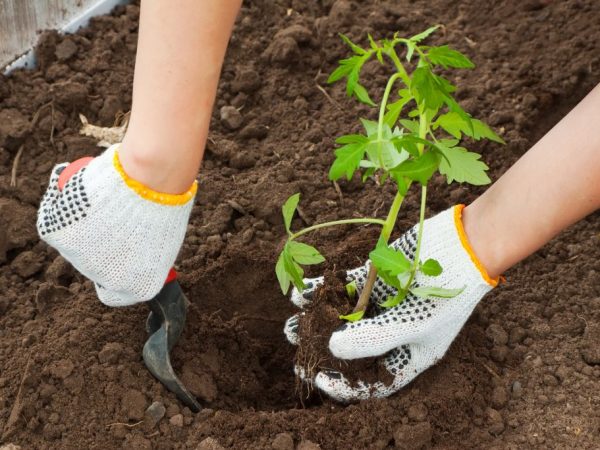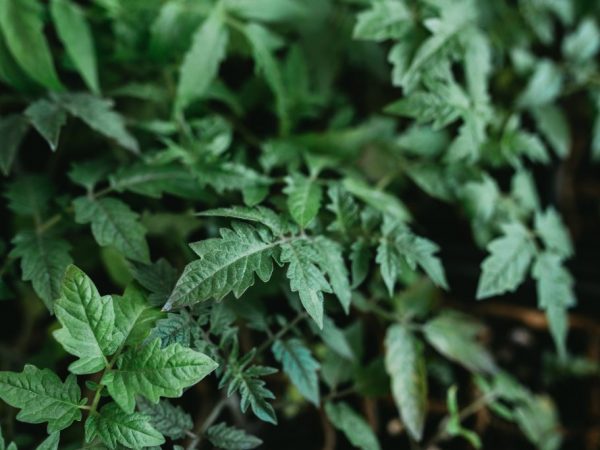Rules for planting tomatoes obliquely
Many gardeners grow tomatoes according to the method of I.M. Maslov. Its essence is planting tomatoes at an angle. It consists in the rational use of the potential inherent in plants - less than half of it is involved in vertical cultivation.

Tomato planting rules obliquely
Principles of the method
By nature, the culture is endowed with the ability to germinate additional roots along the entire length of the stem. It can be seen by looking closely at the plants - there are bumps on them. If you plant the seedlings obliquely, then the nutrition of the tomato bush will significantly increase, which will entail an increase in its productivity:
- for undersized species - 3 times;
- for tall people - up to 10 times.
The fruits will ripen in due time, because the root system is located close to the soil surface. When grown in the usual way, to save space, tomatoes are tied up so that they do not spread. Then the plant does not receive enough nutrients and moisture.
When the technique is relevant
The technique is especially relevant when the seedlings are too elongated and have reached 40-50 cm in height. Then the overgrown seedlings after transplantation directs all forces to the formation of the root system. Therefore, fruiting begins later than usual. In order not to lose the harvest, it is necessary to plant the tomatoes at an angle. Many of these seedlings are planted in the usual way, but they deepen much more and immediately tie them up. Such actions do not always justify themselves for the reason that the lower layers of the earth may still not be sufficiently warmed up. Also, at a depth, the roots receive less oxygen. This slows down the development of culture.
In addition, with a deep planting, a lot of physical labor is spent on planting seedlings, they are planted, which is called "under a shovel."
Other recommendations
It is worth paying attention to the fact that when grown by an inclined method, the fruits of low-growing varieties will be close to the surface of the earth. This will cause them to rot. You can prevent the problem with mulch. The disadvantage of Maslov's method is the fact that these species tend to reduce the size of vegetables by increasing their number.
The following varieties are perfect for growing:
- Russian giant;
- Ukrainian giant;
- Giant.
How to plant
Seedlings are planted when the threat of frost has passed. The soil should be well warmed up. The following landing rules are observed:
- grooves are made in the garden with a depth of 10 cm;
- poured abundantly with water;
- 2/3 of the length of the stem of the seedlings are cleaned of leaves;
- the plants are laid in the grooves while lying down;
- sprinkle with dry earth so that most of the seedlings are under it - only the crown should remain above the surface.
When choosing seedlings, the thickness of the stems is taken into account. The larger it is, the stronger additional roots are formed, which will surpass the main one in strength.
Plants should be planted at a great distance from each other.When laying them, one nuance should be taken into account: the root system should be deployed to the south, and the top of the tomatoes to the north. Then the culture, as it grows, will reach for the sun and acquire an upright position.
Additional nutrient access can also be provided with the help of the lower stepchildren. When they reach the desired length, they are bent down and covered with earth in a layer of 10 cm. Soon, the stepsons take root. Fruiting on them is abundant and occurs close to the soil.
With an inclined planting method, the distance between the bushes should be slightly larger than usual, because when weeding the beds, you can easily damage the root system of the tomato, which is located shallowly. The usual scheme for planting a tomato is 50 x 50 cm.When an inclined method is used, it is advisable to place it according to a scheme of 70 x 50 cm.
Care

Plants are easy to care for
When planting tomatoes obliquely, it is a little easier to care for them, because the plants do not need to be pinned. If you perform this procedure, the tomato will spend a lot of energy on wound healing to the detriment of fruit setting. You should only remove damaged or diseased leaves that are already useless for tomatoes. Also, there is no need to do hilling.
Watering
Water is introduced superficially, in which moistening is carried out using irrigation furrows. They are made in the aisles. In this way, water flows directly to the roots, the earth is not compacted, oxygen is delivered in the right amount. Watering is carried out in the evening as the topsoil dries up. Tomatoes especially need water during the period from the formation of ovaries to the filling of fruits.
Loosening
In order not to form a dry crust on the ground, it is necessary to loosen it after watering or rain. Manipulation is performed when the earth dries up a little. It is also worth weeding regularly, otherwise the weeds will overwhelm the tomatoes.
Garter
A rope is pulled over the site. Twine with loops is attached to it, and elastic bands in the form of a ring are attached to the plants. They are connected with hooks. With this method of garter, the stems will not break, and the fruits will not come into contact with the ground. Plants do not need to spend energy to hold the fruit, they will direct it to pour them.
Top dressing
After planting tomatoes, it is recommended to fertilize the soil in order to increase yields. Top dressing is done at least three times per season, it is possible every two weeks. Culture requires elements such as nitrogen, potassium, phosphorus. The nitrogen content should not be too high. Otherwise, the plants will actively increase the green mass to the detriment of the formation of ovaries. You can use the following tools:
- 5 g of ammonium nitrate;
- 50-60 g of superphosphate;
- 30-40 g of potassium chloride;
- 10 liters of water.
They respond well to the infusion of bird droppings, but its quantity must be carefully monitored. During the flowering period, it is useful to use products containing boron. They will prevent flowers and ovaries from falling off. You can apply the following fertilizer by foliar method: 1 g of boric acid per 1 liter of water. Processing is carried out in the afternoon.
To increase the setting of tomato fruits, especially under unfavorable conditions (low or too high temperature), you can use the Tomaton preparation. Only inflorescences are sprayed with this drug.
Conclusion
It is effective to plant tomatoes lying in greenhouse conditions, if these are tall varieties. It is especially beneficial to cultivate expensive varieties, since the technology allows using a small amount of seed.


